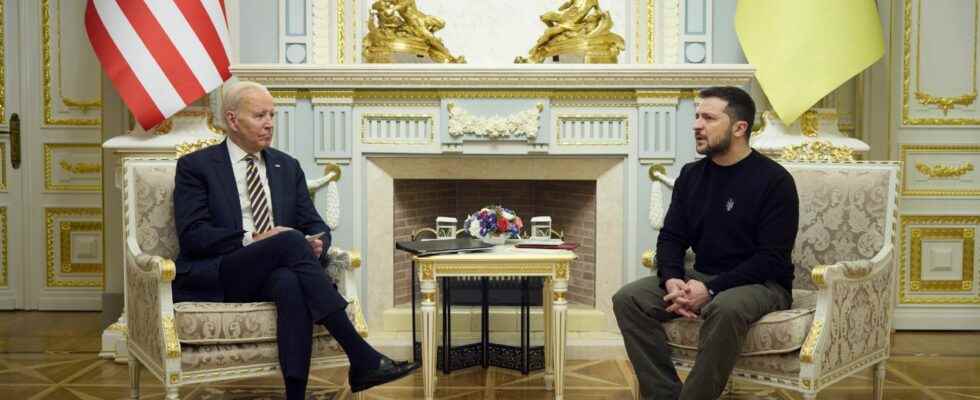The surprise visit went off without a hitch. Joe Biden left kyiv on Monday February 20, a few days before the first anniversary of the Russian invasion. For the American president, it was a chance “to talk with Ukrainian President Volodymyr Zelensky about a conflict with no end in sight and what more the West can do to hasten its conclusion – and ensure that that it takes place according to the conditions of Ukraine”, underlines the American media Politico. The Head of State promised new weapons to Ukraine and assured this country of the “unwavering” support of the United States in the face of the Russian invasion. The objective: to send a message to the allies and to Russia. In a statement after his arrival, Joe Biden said that Vladimir Putin “thought Ukraine was weak and the West was divided. He thought he could survive us. But he was wrong.”
This visit was also an opportunity to reaffirm military support: “I will announce the delivery of other essential equipment, including artillery ammunition, anti-armor systems and air surveillance radars”, he said. indicated, according to a statement from the White House. Joe Biden promised Kiev a new tranche of military aid of 500 million dollars in the coming days “but he did not mention the advanced weapons that Ukraine is asking for”, notes The New York Times. Note that the United States has already provided more than 30 billion dollars in military aid over the past year. and Congress has allocated a total of more than 100 billion to Ukraine, again according to the newspaper.
This trip was organized in the greatest secrecy. This visit was “particularly delicate”, underlines The New York Times. “During the past year, American officials traveling to Kyiv have chosen not to fly there directly, because of the missile risks. They have opted for an overnight train trip from Poland, which can take more than seven hours but which is considered safer, before spending a few hours there and then returning by train without sleeping in Kyiv.” The American media speaks of a “testing journey” for an 80-year-old president. As a reminder of the risks of such a trip, anti-aircraft sirens sounded in kyiv, as Joe Biden came out of a church, accompanied by his Ukrainian counterpart, where they had stayed for a few minutes
“A bold gesture of support”
Deputy National Security Adviser Jon Finer told reporters that the visit was “meticulously planned over a period of several months,” with the White House, the office of the Chief of Staff, the NSC, the White House military office and members of the Pentagon, Secret Service and intelligence community. The final decision to go to Kyiv was made on Friday February 17 in the Oval office. Jake Sullivan, security adviser to the American president, said that the United States had warned Russia of the visit of Joe Biden, before his departure, in order to avoid any conflict.
Asked by CNN, Jack Sullivan, added that the American president considered that the risk on the ground was “manageable”. “It was a risk that Joe Biden wanted to take,” said communications director Kate Bedingfield. “It’s important for him to show up, even when it’s difficult, and he led his team to make that happen, no matter how complicated the logistics were.” The media USA Today recalls that “there are few, if any, examples of US presidents traveling to an active war zone where there is no US troop presence. Ukrainian officials have been warning for weeks that Russia could plan a major new offensive around the first anniversary of the war.” For its part, CNN speaks of an “unprecedented” trip and the Los Angeles Times of a “bold gesture of support”.
This surprise trip comes before Joe Biden’s two-day visit to Poland. The president is due to travel to Warsaw on Tuesday, February 21, where he will meet Polish President Andrzej Duda. In another article, the site Politico wonders why the American president did not move before: “He wanted to go there last year” but it was necessary “to take into account the logistical considerations and the security problems”, declared an American official, who is expressed on condition of anonymity.
For its part, the media Foreign Policy turns out to be less complimentary and looks back on the years leading up to the Ukrainian invasion: “From President George W. Bush’s lukewarm response to the 2008 invasion of Georgia, to the Biden administration’s half-hearted gestures of support for Ukraine, the American leadership gave the impression that the United States was unwilling to respond to a new assault from Russia. The result was yet another war, extremely costly.” With this visit, the American president has proven that he will henceforth remain at the bedside of Ukraine.
